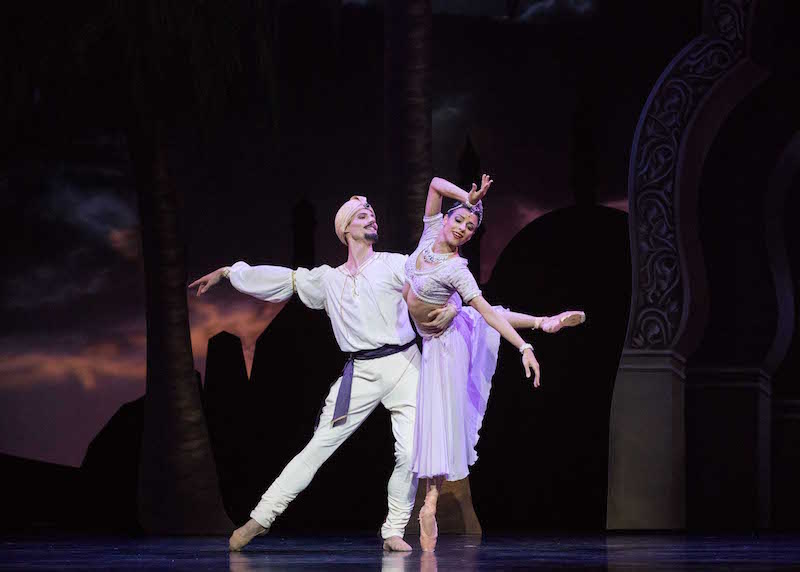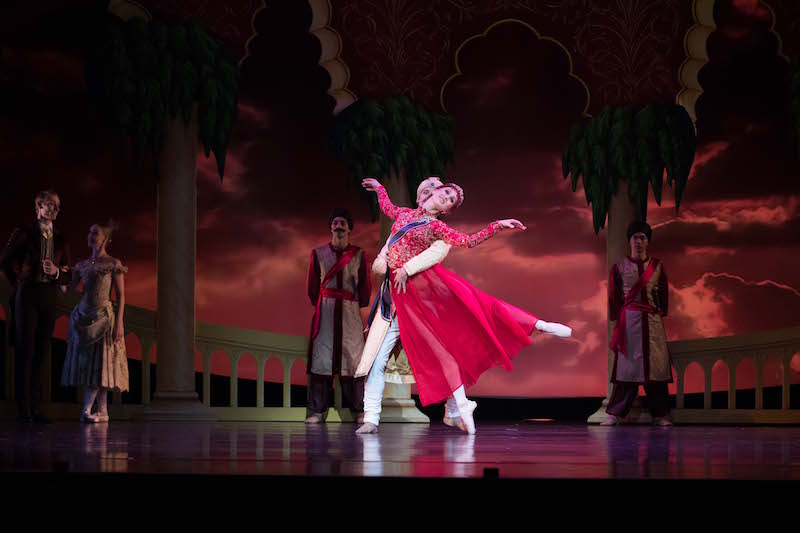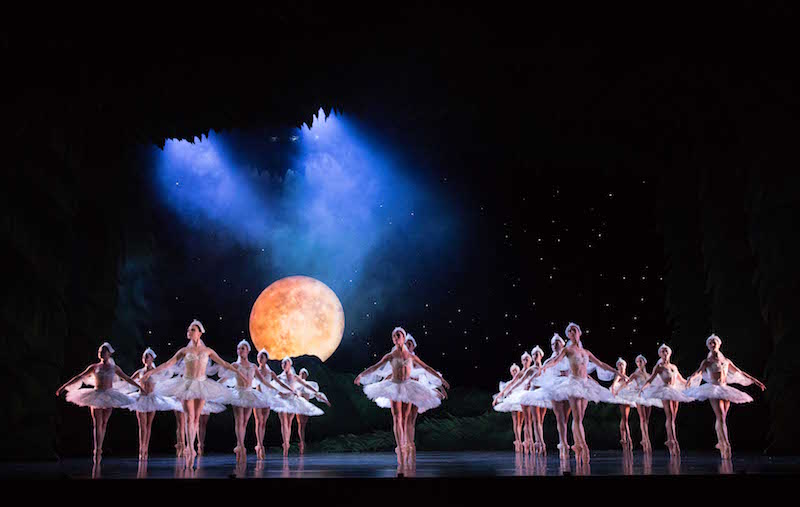Playhouse, Queensland Performing Arts Centre, Brisbane
March 16, 2018
La Bayadère may not be a particularly well-known or frequently performed ballet, but that hasn’t stopped the Queensland Ballet from producing a brand-new rendition of the 1877 original. And it certainly hasn’t been done by half measures. There are new passages of choreography, a rearranged score, dozens of lavish costumes and a grand new set design. It may seem like a risky endeavour on paper, but thanks to the skilfull handling of the creative team and the reframing of the storyline as something more tangible than pure fantasy, this production certainly satisfies and occasionally exceeds expectations.
 Joel Woellner and Yanela Piñera. Photograph © David Kelly
Joel Woellner and Yanela Piñera. Photograph © David Kelly
Most productions of La Bayadère are set in an exotic fictionalised India and tell the tale of a noble warrior who, despite professing his undying love for a bayadère (a temple dancer), finds himself in an arranged marriage to another woman. This love triangle is retained in the Queensland Ballet’s version, but director and choreographer Greg Horsman has sought to recontextualise the narrative in a more “real” India. It is 1855 – the height of the British occupation – in the princely kingdom of Cooch Behar, where the British and local armies are at war. The royal warrior, Solor, finds himself as a mere pawn in a dangerous game of politics, with dire consequences for himself and the women who enter his life.
Realising the inherent dramatic potential of the storyline, Horsman has made smart decisions about what of Marius Petipa’s original choreography to keep and what to rework. For some of the ensemble scenes, Horsman has created original material that cleverly blends classical Indian dancing with ballet. We recognise traces of the former in highly articulated movements of the fingers and wrists, the folding of arms into right angles, and the digging of heels into the ground. A genius moment emerges in an early scene when a line of temple dancers execute a delicate arm sequence in canon to resemble a Hindu deity such as Durga.
As the work progresses, this fusion of genres becomes less pronounced – perhaps a missed opportunity to further locate the ballet inside a “real” India. But while the choreography defaults to a more pure and familiar balletic form, this does give us the opportunity to see significant sections of Petipa’s original choreography as intended. The famous and technically demanding Kingdom of the Shades scene in the second act is a particular highlight.
 Georgia Swan and Joel Woellner. Photograph © David Kelly
Georgia Swan and Joel Woellner. Photograph © David Kelly
Weaving throughout these scenes are the solos and pas de deux that drive the narrative arcs of the main characters. On opening night, soloist Joel Woellner delivered a passionate and honest rendering of Solor, a warrior evidently torn between following his heart and honouring his duty to his father (and thereby the entire princely kingdom). Principal Yanela Piñera’s performance as the temple dancer, Nikiya, had quiet strength, exquisite control and genuine sensitivity. Company artist Georgia Swan was a standout as the warrior’s bride, Edith (renamed from Gamzatti in other versions). The role demanded acting skills of great breadth – humour, obsession, jealousy, rage – and Swan met each of these with aplomb; never slipping into a caricature of a woman scorned.
While Horsman’s conceptual and choreographic contribution is obviously significant to the success of this production, it is by no means absolute. He has been very ably assisted by musical director Nigel Gaynor’s newly arranged score, played under his hand by the Queensland Symphony Orchestra. Gaynor’s arrangement enhances certain elements of Ludwig Minkus’ original score by adding Indian instrumentation, subtly altering melodies, and setting movements in a harmonic minor key (rather than the original major) to sound more exotic. From the first few plucks of the sitar strings in the opening moments of the ballet, it is clear we are situated in a recognisable but foreign place.
 Artists of the Queensland Ballet. Photograph © David Kelly
Artists of the Queensland Ballet. Photograph © David Kelly
The particularity of the score is matched in Gary Harris’ stunning design. Basing his ideas on historically accurate dress from the relevant time period, Harris’ costumes speak to both the British formal and corseted style of the 19th century, and the wild colours of traditional Indian dress. The dancers are adorned in luxurious fabrics and sparkling jewels – a level of opulence that is matched in Harris’s grand set pieces, which are subliminally illuminated by Jon Buswell’s lighting design. The final image of the ballet – the two lovers spinning against a backdrop of a seemingly three-dimensional sunset through which light bursts out into the theatre – is indescribably beautiful.
Horsman’s decision to retell La Bayadère in a more realistic way ultimately proves to be a rewarding decision. With the help of a reworked and extended score and a lavish design, the story is clearly and compellingly told by a cast of accomplished leads and a strong corps de ballet.
La Bayadère plays until March 31











Comments
Log in to join the conversation.